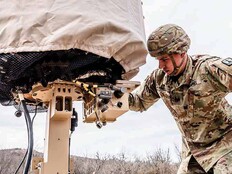Air Force, NGA Embrace AI in Different Ways
Artificial intelligence helps federal agencies in a variety of ways, including via chatbots that take care of customers’ basic needs and computer vision technology that enables machines to identify objects in still pictures or activity in video footage in seconds, saving hours of human labor.
The National Geospatial-Intelligence Agency has been an enthusiastic proponent of computer vision. NGA, which collects and examines geospatial intelligence and distributes data to the Defense Department and national security community, is one of several defense-related agencies that have embraced AI.
The agencies are using AI for different aspects of their missions and have varying stances on how to implement artificial intelligence, with some officials urging agencies not to get caught up in the hype on the technology.
MORE FROM FEDTECH: Find out how voice assistants can streamline customer service for agencies.
Air Force Uses AI to Cut Down Maintenance Time and Costs
AI can provide defense agencies with benefits that save costs and potentially lives, explained Defense Innovation Unit Director Mike Madsen last month at the CXO Tech Forum: AI and Big Data in Government in Arlington, Va., according to GovernmentCIOMedia.
However, officials who spoke at the event also noted that agencies need to take privacy and human rights into account when deploying AI solutions.
“We need to operate faster than our adversaries” by keeping up with AI and machine learning advancements, Madsen said. DIU focuses on identifying highly relevant technology companies and matching them to Defense Department customers through collaborative, agile business processes.
Yet doing so means that U.S. agencies may face ethical challenges. Big Data technologies were “born for surveillance,” said Mike Olson, chief strategy officer at software provider Cloudera, according to GovernmentCIOMedia. “We are a democracy committed to human rights. … We need to think of the ethical implications of the technologies we build.”
There are clear benefits to AI. The Air Force and DIU worked together on a predictive maintenance solution that ingested about seven years’ worth of data from a single airframe platform. As a result, the Air Force was able to cut unscheduled maintenance time for aircraft by 30 percent, boosting the fleet’s maintenance reliability rate.
“In the aircraft maintenance world, they collect huge amounts of data, but they’re just now learning how to how to manipulate this for things like predictive maintenance,” Madsen said, according to Federal News Network.
The Army plans to deploy such technology for its Bradley Fighting Vehicles, and the Marine Corps has expressed interest as well, Madsen added.
NGA, Army Research Have Different Approaches to AI
NGA Director Robert Cardillo has been a proponent of computer vision. In June 2017, at a conference in San Francisco hosted by the United States Geospatial Intelligence Foundation, Cardillo said that, at some point, computers may perform 75 percent of the tasks NGA analysts currently do, according to a Foreign Policy report.
According to Foreign Policy, Cardillo said he sees AI as a “transforming opportunity for the profession” and is trying to show analysts that the technology is “not all smoke and mirrors.” The message Cardillo wants to get across is that computer vision “isn’t to get rid of you — it’s there to elevate you. It’s about giving you a higher-level role to do the harder things.”
NGA wants to build its AI tools and talent in-house. “We wanted to revitalize the skill set and the ownership, from the government perspective, of having federal employees that can code,” as well as develop Software as a Service applications using AI, Todd Myers, NGA’s automation lead, said at the event, according to Federal News Network.
NGA also wants its analysts to understand the history of AI and how the technology has developed. “There’s context there, and it’s been completely lost. And you don’t get that by buying AI and machine learning from a company — you get that from developers in government taking ownership and developing against context for mission relevancy,” Myers said.
Over the past two years, NGA has worked to develop relationships with commercial technology players in Silicon Valley and has been trying to get that kind of code into its operations. “We’re bringing the ownership in on my team, to deliver from the government out, which is converse to a lot of the way things are done,” Myers said.
“The challenge is the amount of activities that understand code source and pipeline delivery and comprehend what to do in their organizations to bring this in is foreign,” Myers added, according to GovernmentCIOMedia. “We have to normalize these environments. You don’t buy this, you own it.”
Meanwhile, Alexander Kott, the chief scientist of the Army Research Laboratory, said agencies should be realistic about AI and not give in to “irrational exuberance” over what the technology can do for them.
“Let’s not be part of the snake-oil seller crowd for AI. Let’s be realistic about AI — let’s focus on what it can do for the specific tasks speed of specific missions of your organization,” Kott said, according to Federal News Network. “If it’s appropriate, it’s appropriate. If it’s not appropriate, don’t sell it.”
While Kott conceded AI has practical benefits for government, he maintained it is not right in every context. “If it is already being attempted to be automated, you probably need to ask yourself: Why did it fail before? AI is not a magic pixie dust that you can sprinkle on your problem and it suddenly will get solved,” he said.










